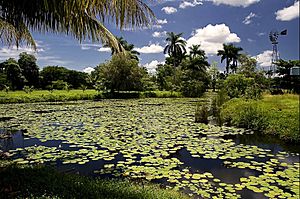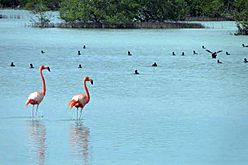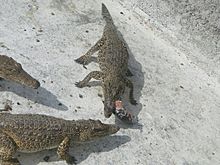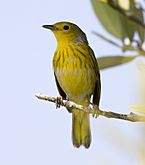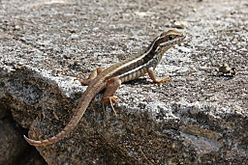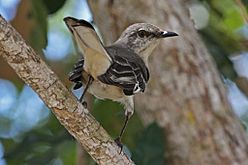Zapata Swamp facts for kids
Quick facts for kids Ciénaga de Zapata |
|
|---|---|
|
IUCN Category II (National Park)
|
|
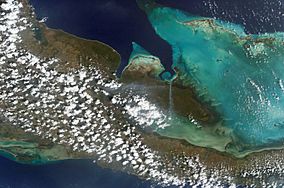
Zapata Swamp as seen from space. South is towards the top.
|
|
| Location | |
| Nearest city | Playa Larga Jagüey Grande |
| Area | 4,354.3 km2 (1,681.2 sq mi) |
| Official name: Ciénaga de Zapata | |
| Designated: | 12 April 2001 |
| Reference #: | 1062 |
The Zapata Swamp (called Ciénaga de Zapata in Spanish) is a huge wetland area in Cuba. It's found on the Zapata Peninsula in the southern part of Matanzas Province. This amazing natural spot is less than 150 kilometers (about 93 miles) southeast of Havana. It's a very important place for many plants and animals.
Contents
Amazing Animals and Plants of Zapata Swamp
The Zapata Swamp is home to an incredible variety of living things. You can find over 900 types of native plants here. There are also 175 different kinds of birds, 31 types of reptiles, and more than 1,000 kinds of insects and other small creatures.
Unique Animals You'll Find Here
Some animals found in the Zapata Swamp live nowhere else in the world! They are endemic to Cuba.
- Birds: Look out for special birds like the Zapata wren, Zapata rail, and the Zapata sparrow. The swamp is also a key home for the bee hummingbird. This tiny bird is the smallest bird species on our planet!
- Migrating Birds: Many birds visit the Zapata Swamp during their long journeys. About 65 different bird species stop here as they migrate from North America, through the Caribbean, and down to South America.
- Crocodiles: The swamp is famous for the Cuban crocodile (Crocodylus rhombifer). This type of crocodile lives only in the Zapata Swamp. Efforts are being made to reintroduce them to another nearby swamp. You might also see the American crocodile (Crocodylus acutus) here. Sometimes, these two types of crocodiles even have babies together!
Protecting This Special Place
The Zapata Swamp is very important, so many parts of it are protected. These areas help keep the environment safe. The Zapata Swamp Natural Reserve and Las Salinas wildlife sanctuary are examples. They are part of a much larger area called the Ciénaga de Zapata Biosphere Reserve. This reserve covers over 6,000 square kilometers (about 2,300 square miles). It's the biggest protected area in all of Cuba and even the entire Caribbean!
The swamp is not just big; it's also one of the best-preserved wetlands in the Antilles. Because it's so important, it was named a "Wetland of International Importance" by the Ramsar Convention on Wetlands in 1971. More of the swamp was added to this special list in 2001.
Where is the Zapata Swamp?
The Zapata Swamp is located between 22°01’ and 22°40’ North latitude and between 80°33’ and 82°09’ West longitude. It covers more than one million acres (about 4,000 square kilometers).
Land and Water Features
The highest point in the swamp is only about 10 meters (33 feet) above sea level. In areas near the coast, the water can be up to 2 meters (6.5 feet) deep in salty marsh areas. In the sea coastal zone, the depth can range from 1 meter (3 feet) to an amazing 600 meters (nearly 2,000 feet)!
Weather in the Swamp
The Zapata Swamp has two main seasons:
- Warm Season: From May to October, it's the warmest time of year. The average temperature is around 30°C (86°F).
- Cool Season: From November to April, it's cooler. The average temperature is about 20°C (68°F).
Gallery
See also
 In Spanish: Ciénaga de Zapata para niños
In Spanish: Ciénaga de Zapata para niños
- Ernst Thälmann Island
- Geography of Cuba
- Protected area
- Ramsar Convention
- World Conservation Monitoring Centre



